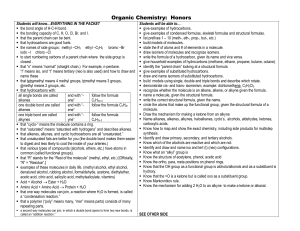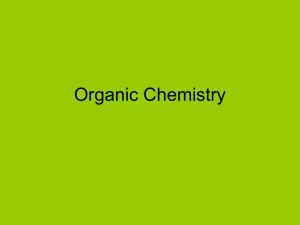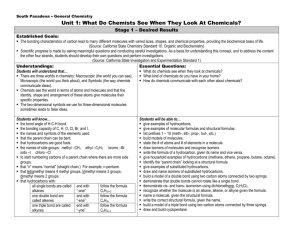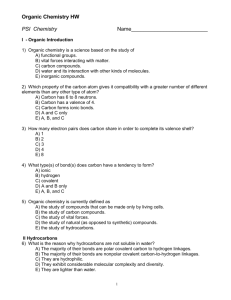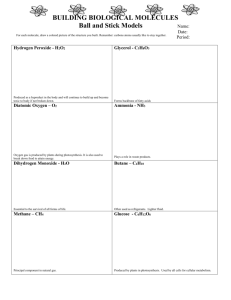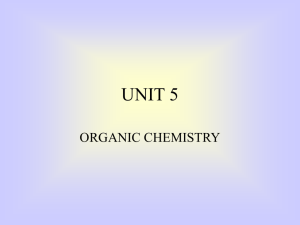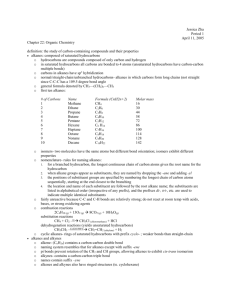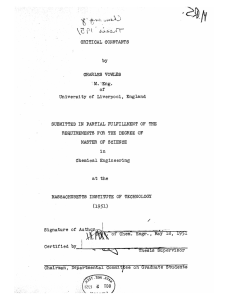South Pasadena · Chemistry
advertisement
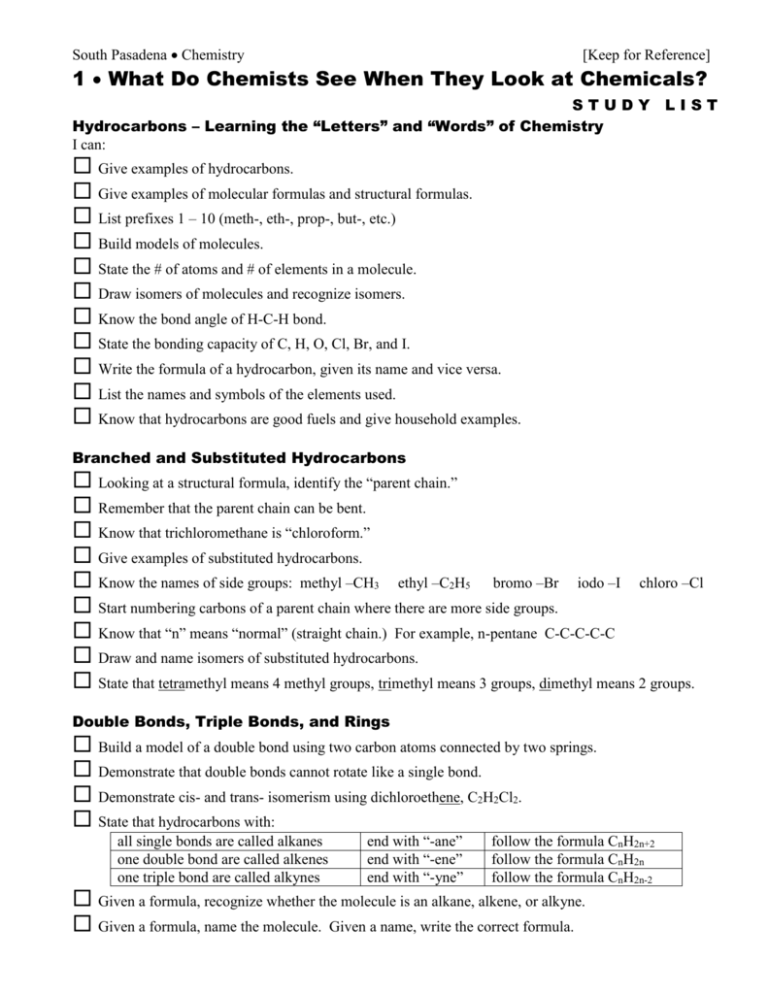
South Pasadena Chemistry [Keep for Reference] 1 What Do Chemists See When They Look at Chemicals? STUDY Hydrocarbons – Learning the “Letters” and “Words” of Chemistry I can: LIST Give examples of hydrocarbons. Give examples of molecular formulas and structural formulas. List prefixes 1 – 10 (meth-, eth-, prop-, but-, etc.) Build models of molecules. State the # of atoms and # of elements in a molecule. Draw isomers of molecules and recognize isomers. Know the bond angle of H-C-H bond. State the bonding capacity of C, H, O, Cl, Br, and I. Write the formula of a hydrocarbon, given its name and vice versa. List the names and symbols of the elements used. Know that hydrocarbons are good fuels and give household examples. Branched and Substituted Hydrocarbons Looking at a structural formula, identify the “parent chain.” Remember that the parent chain can be bent. Know that trichloromethane is “chloroform.” Give examples of substituted hydrocarbons. Know the names of side groups: methyl –CH3 ethyl –C2H5 bromo –Br iodo –I chloro –Cl Start numbering carbons of a parent chain where there are more side groups. Know that “n” means “normal” (straight chain.) For example, n-pentane C-C-C-C-C Draw and name isomers of substituted hydrocarbons. State that tetramethyl means 4 methyl groups, trimethyl means 3 groups, dimethyl means 2 groups. Double Bonds, Triple Bonds, and Rings Build a model of a double bond using two carbon atoms connected by two springs. Demonstrate that double bonds cannot rotate like a single bond. Demonstrate cis- and trans- isomerism using dichloroethene, C2H2Cl2. State that hydrocarbons with: all single bonds are called alkanes one double bond are called alkenes one triple bond are called alkynes end with “-ane” end with “-ene” end with “-yne” follow the formula CnH2n+2 follow the formula CnH2n follow the formula CnH2n-2 Given a formula, recognize whether the molecule is an alkane, alkene, or alkyne. Given a formula, name the molecule. Given a name, write the correct formula. Build a model of a triple bond using two carbon atoms connected by three springs. Know that “cyclo-“ means the molecule contains a ring. Draw and build cyclopentane. Know that “saturated” means “saturated with hydrogens” and describes alkanes. Know that alkenes, alkynes, and cyclic hydrocarbons are all “unsaturated.” State why unsaturated fats are better for you (the double bond makes them easier to digest and less likely to coat the inside of your arteries.) Functional Groups Know the “big idea” that various types of compounds (alcohols, ethers, etc.) have atoms in common (called functional groups). Given the structural formula of a molecule, circle the atoms that make up the functional group. alcohol aldehyde ketone ether (bunny) carboxylic acid ester amine amide Know that “R” stands for the “Rest of the molecule” (methyl, ethyl, etc.) [Officially, “R” = “Residue”.] State examples of these molecules in daily life. (methyl alcohol, ethyl alcohol, denatured alcohol, rubbing alcohol, formaldehyde, acetone, diethylether, acetic acid, maleic acid, citric acid, salicylic acid, methylsalicylate, vitamins, and amino acids) Draw the structural formula and the shortcut picture of a benzene ring. Name the three positions of a disubstituted benzene ring (ortho-, meta-, and para-). Reactions – Condensation Reactions and Addition Reactions Acid + Alcohol Ester + H2O Amino Acid + Amino Acid Protein + H2O State one way molecules can join: a reaction where H2O is formed is called a “condensation reaction.” Know that a polymer (“poly” means many, “mer” means parts) consists of many repeating parts. State natural examples of polymers such as proteins (many amino acids), carbohydrates (many sugar units), and DNA (many nucleotide bases). State man-made polymers like polyester (many ester linkages), and polyethylene, polystyrene, and Teflon. State a second way molecules can join: a double bond opens to form two new bonds. called an “addition reaction.” Know that this is Given a monomer (like ethane, aka. ethylene), draw the “repeat unit” with the double bond open, copy the repeat unit to draw the polymer. Give examples of common substances made from addition polymers.


